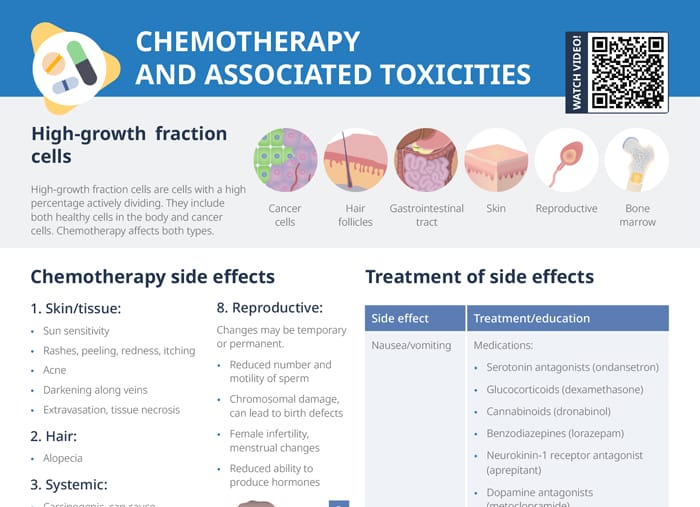What is chemotherapy?
Chemotherapy is a type of cancer treatment. Initially, the term chemotherapy referred broadly to the use of chemicals for therapeutic purposes, but over time, its meaning narrowed to specifically denote the use of chemical substances to treat cancer.
How does chemotherapy work?
Chemotherapy works by killing or slowing the growth of high-growth fraction cells in the body. The specific drugs and schedule used vary depending on the type of cancer, its stage, goals of treatment, etc.
What are high-growth fraction cells?
High-growth fraction cells are cells with a high percentage actively dividing. They include both healthy cells in the body and cancer cells. Chemotherapy affects both types, which leads to side effects due to the treatment attacking healthy cells in the body.
How is chemotherapy administered?
Chemotherapy can be administered in various ways, including orally (pills or liquid), intravenously (IV), injected into a specific area (intra-arterial or intraperitoneal), or topically (cream). The treatment is often given in cycles, with periods of treatment followed by rest periods to allow the body to recover. The duration of treatment varies depending on the type and stage of cancer, the goals of treatment, and how the body responds.
How effective is chemotherapy?
The effectiveness of chemotherapy varies highly depending on:
- The type, characteristics, and stage of cancer
- Overall health of the client
- Treatment goals (curing, controlling growth, palliative care)
- Combination with other treatments (such as surgery)
- Some cancers may become resistant to chemotherapy over time.
What are the side effects of chemotherapy?
Skin and tissue side effects
Chemotherapy can lead to
- Sun sensitivity
- Rashes, peeling, redness, and itching
- Acne
- Darkening along the veins
- Extravasation and tissue necrosis
Side effects related to hair, kidneys, cardiac system and GI tract
- Alopecia (often distressing for patients, affecting self-image and emotional well-being)
- Hyperuricemia
- Gout
- Heart damage
- Stomatitis
- Diarrhea
- Nausea and vomiting (can be severe and persistent, affecting nutrition and quality of life)
Systemic side effects
- Chemotherapy is carcinogenic: It can cause other secondary cancers.
- Chemotherapy patients often experience persistent fatigue that does not improve with rest.
Bone marrow suppression
Chemotherapy leads to decreased neutrophils, thrombocytes, and erythrocytes (anemia, bleeding issues). Neutropenia, a significant decrease in white blood cells, leads to a heightened risk of infection, which can be life-threatening.
Chemotherapy effects on the reproductive system
Changes to the reproductive system due to chemotherapy may be temporary or permanent. They include:
- Chromosomal damage (can lead to birth defects)
- Fertility issues (reduced number and motility of sperm, female infertility, menstrual changes)
- Reduced ability to produce hormones
How to minimize chemotherapy side effects: nursing interventions
Table: Treatment of chemotherapy side effects
| Side effect | Treatment |
| Nausea and vomiting | Serotonin antagonists, glucocorticoids, cannabinoids, benzodiazepines, neurokinin-1 receptor antagonists, dopamine antagonists, atypical antipsychotics |
| Leukopenia | Precautions: Meat must be well-done, avoid fresh flowers/fruit/vegetables. |
| Decreased neutrophils | Medications to increase neutrophils |
| Thrombocytopenia | Precautions: Reduce bleeding risk (use electric shaver, soft toothbrush, avoid activities that could involve injury orbruising). |
| Decreased RBCs | Medication to stimulate RBC production:erythropoietin (only if client doesn’t haveleukemia) |
| Anemia | Conserve energy. |
| Hyperuricemia | Allopurinol |
Chemotherapy precautions for nurses
As a nurse, you may be involved in administering chemotherapy, monitoring patients during treatment, managing side effects, and providing education and support to patients and their families.
Nursing precautions around chemotherapy
- Use of personal protective equipment (PPE) and preventing exposure, ensure proper ventilation
- Patient education and support (also about safe handling of bodily fluids and excreta)
- Safe handling and proper disposal of drugs (can be toxic)
- Pregnant nurses should avoid direct handling due to potential for teratogenicity.
- Monitor patients for adverse reactions during and after administration.
- Some institutions require nurses to have chemotherapy certification.
Chemotherapy precautions for clients
- Clients should be prepared for potential side effects and receive guidance on how to handle them. Encourage self-care and focus on ensuring solid emotional and practical support systems.
- Advise clients to practice good hygiene for infection prevention.
- Encourage clients to maintain strength through a balanced diet and hydration.
- Stress the importance of medication adherence and follow-up appointments.
- Educate clients on bodily fluid handling (sexual activity, handling urine, stool, vomit after treatment) and safe storage of drugs at home.
What is a chemotherapy nurse?
Chemotherapy nurses (or oncology nurses) specialize in caring for patients receiving chemotherapy for cancer treatment. Their skills and tasks include:
- Administering chemotherapy
- Assessment and monitoring
- Patient education and support
- Managing side effects of chemotherapy
- Focus on safety protocols around chemotherapy drugs
Not all chemotherapy nurses have additional certification on top of their RN, but it can help hone your skills and signal your expertise to employers. Certifications can, for example, be obtained through the Oncology Nursing Certification Corporation (ONCC).

